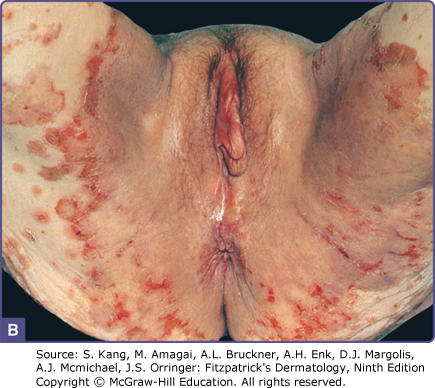Dermatology Question of the Week: Medical Mysteries

A 65-year-old female presents for evaluation of a rash that is quite diffuse with individual lesions that are enlarging and seem to disappear and reappear in different areas of the skin as serpiginous patches with small easily ruptured vesicles and erosions with crusting. The rash does not appear to be predominantly in sun-exposed areas such as the neck and the acral surfaces are also spared. The patient also reports weight loss and diarrhea. Recently blood work revealed a normal zinc level and normal alkaline phosphatase level.

Which of the following would be most consistent with the patient's presentation?
A. Acrodermatitis enteropathica
B. Necrolytic acral erythema
C. Pancreatic tumor
D. Pellagra
Rationale: Although several of the answer choices can appear similar clinically and have histologic overlap, certain clues in the patient's history and laboratory results provide enough evidence for the correct diagnosis. When suspecting any of these diagnoses, it is important to rule out other similar diagnoses.
Correct answer: C. Pancreatic tumor
The rash pictured above, along with the clinical vignette, is a prototypical example of necrolytic migratory erythema which is most commonly attributed to a glucagonoma. Although the pathogenesis is not completely understood, excessive glucagon secretion leads to metabolization of amino acids leading to decreased levels available for skin homeostasis. Patients frequently have secondary vitamin deficiencies which may contribute to the development of the skin findings. Serum glucagon levels, glucose tolerance testing, and abdominal imaging can help achieve the diagnosis and locate the tumor. Resection of the tumor commonly results in the resolution of the rash although other treatment options such as octreotide are available.
Incorrect answers:
A. Acrodermatitis enteropathica is a rash typically located in the perioral, acral, and genital areas consisting of sharply demarcated scaly plaques. It is associated with zinc deficiency and early disease may occur in those with normal serum zinc levels; alkaline phosphatase is a helpful adjunctive test as it is a zinc-dependent enzyme and early deficiency may be detected by low levels of alkaline phosphatase in blood.
B. Necrolytic acral erythema is associated with hepatitis C and involves flaccid bullae and plaques on the acral surfaces.
D. Pellagra occurs secondary to niacin (vitamin B3) deficiency and is commonly remembered by the 4 D's: Dermatitis (photodistributed rash including perioral rash, Casal's necklace, and acral involvement), Diarrhea, Dementia, and Death.
Additional reading at Fitzpatrick's Dermatology Chapter 134: Cutaneous Paraneoplastic Syndromes

Create a Free MyAccess Profile
AccessMedicine Network is the place to keep up on new releases for the Access products, get short form didactic content, read up on practice impacting highlights, and watch video featuring authors of your favorite books in medicine. Create a MyAccess profile and follow our contributors to stay informed via email updates.